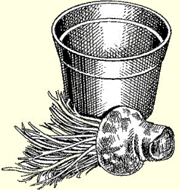 |
The Bay Gardener
By Dr. Frank Gouin
|
Bringing in the House Plants, II
Fine foliage starts at the roots
The best way to find out if a plant needs to be repotted is to pull it from its container and examine the roots.
Some houseplants have to be repotted every six months while others can stay put for two or three years. Frequency of repotting also depends on container size, quality of care, productivity of the rooting medium and frequency of nutrient applications. Annuals — such as grape ivy, begonias and marigolds — have very vigorous habits of growth and should be repotted at least twice yearly. Foliage plants such as ficus, schefflera and crotons tend to grow slowly and can be left alone for a year or two, depending on the age of the plant and container size.
For the top of a plant to grow, its roots must grow. If only roots are visible when you remove the plant from its container, the plant is root bound. That does not necessarily mean that the plant must go into a larger container. If the plant is already growing in the largest container available or you don’t have space for a huge pot, use the same container, but cut out some of the roots and fill the void with fresh rooting medium. That’s an old practice used for centuries by the Japanese in growing bonsai.
Use a sharp knife or pruning shears to cut the outer inch to one and a half inches of the root mass all the way around the root ball. If you are re-planting into a larger container, slash or tear apart most of the outer roots of the root ball.
Next, shake away as much as possible of the soil from between the roots in the center of the root ball. Discard the old soil and roots in the compost pile and replace with fresh rooting soil.
Make the best rooting medium yourself, mixing equal parts by volume garden soil, compost from your garden or commercial compost and perlite. Place in a microwaveable container and microwave at full power for 15 minutes for each gallon of potting soil. Cool before using. Store the unused rooting medium in a plastic bag so that it will remain moist.
Or improve commercial media by adding one-third by volume compost such as LeafGro, Chesapeake Blue or Green. Peat moss-blended media shrink over time; avoid them.
Using your thumbs, press the rooting medium firmly into the center of the root ball and between the root ball and the walls of the container.
Next, flood the surface of the rooting medium to wash it into cavities. After the water drains, fill with additional medium.
Unless the roots of a root-bound plant are disturbed during repotting, the plant will stay root bound despite having fresh rooting medium.
Don’t be afraid to disturb the roots of plants. This nudge will help them spread out in their new digs.
Ask Dr. Gouin your questions at [email protected]. All questions will appear in Bay Weekly. Please include your name and address.